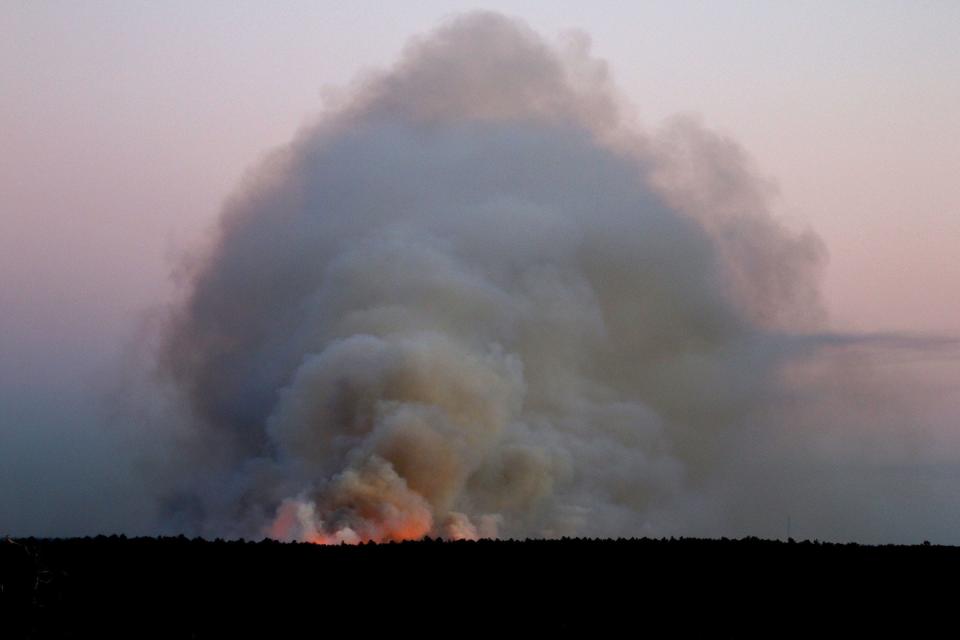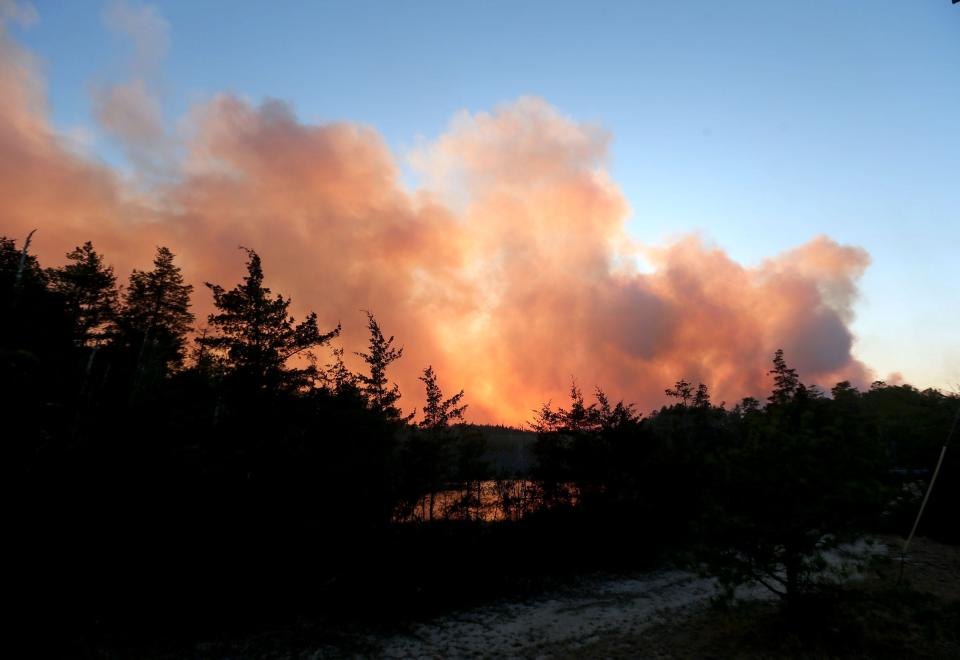Red flag warning: Wildfire season is expanding in NJ, and a warm, dry February didn't help
Little rain in February made for dry conditions across much of New Jersey, conditions that could contribute to wildfires like the one that burned more than 400 acres in Little Egg Harbor this month, said New Jersey State Climatologist David Robinson.
Only 1.55 inches of rain and melted snow fell on the Garden State in February, which helped create a particularly dry forest in the Pine Barrens, Robinson said. It could worsen a wildfire season officials say is getting longer.
"That was the 11th driest February on record," he said. "We go back to 1895 (in years of weather records)."
Extremely dry forest fuels and high winds contributed to potentially dangerous conditions for wildfire across portions of the Pinelands, including areas within Ocean and Monmouth counties such as Berkeley, western Lacey and Cream Ridge in Upper Freehold, according to U.S. Forest Service information shared by Rutgers University.
Blustery, dry conditions helped fuel the wildfire in Little Egg Harbor this week, which was quickly contained by the New Jersey Forest Fire Service at 418 acres.

Fire officials also say wildfire season, which typically runs from mid-March to mid-June, has been expanding in recent years.
"The last three, four years, we've been seeing wildfires in February and early March and mid-March," said Chief Greg McLaughlin of the New Jersey Forest Fire Service. "We're doing prescribed burning, and yet… we're stopping, and then we're responding to wildfires."
The New Jersey Pinelands — because of its quick-drying sandy soils, dense pine forest and weather patterns — are among the most fire-prone ecosystems in the nation.

"Pinelands fires burn extremely hot and spread rapidly," according to a 2019 hazard mitigation plan by the New Jersey Office of Emergency Management. "New Jersey has a high population density and more people are moving from urban areas to build homes in rural wildland areas. With more people living in and enjoying the State’s wildlands for various forms of recreation, the number of potential fire starts and the seriousness of their consequences increases."
The Pinelands National Reserve covers over 1 million acres and covers 22% of New Jersey's land area, with busy towns and housing developments along the edges of the region. At the center of the reserve lies more than 288,300 acres of largely untouched pine forest.
Fire risk in these Pinelands communities is determined through a complex formula of variables: air temperature, humidity, forest fuel moisture and temperature, along with wind speed and gusts. High winds and dry conditions make for the most dangerous weather within the New Jersey Pinelands, according to weather and climate experts.
"It's really humidity that drives the boat here," said Ray Martin, a meteorologist at the Mount Holly station of the National Weather Service. "You oftentimes will get a cold front that moves through and we'll get some very dry Canadian air moving in behind it. So even though it's colder, it could also be a lot drier than it was ahead of the cold front. And that can result in increased fire danger."
Last June, it was unusually low humidity that helped fuel New Jersey's largest forest fire in more than a decade. An illegal campfire burned out of control, scorching more than 13,500 acres.
New Jersey's Pinelands towns are entering peak wildfire season, he said.
"We can get these rapid warm-ups, because the sun is stronger this time of year, but the air can still be very dry moving down from Canada and with gusty winds," Martin said.
Late February and early March is typically the time of year when firefighters use prescribed burning to thin underbrush and leaf litter that fuels massive wildfires, said McLaughlin.
Related:Wildfire in Little Egg Harbor contained at 418 acres
On Wednesday night, the Forest Fire Service responded to another fire not far from where Tuesday's fire erupted, near Routes 72 and 539, he said. Wednesday's fire burned 38 acres, he said.
Neither fire was related to prescribed burning, the fire chief said.
"So far this year, we've had 189 wildfires already," he said, "and that's burned or consumed… 644 acres."
Last year, the Forest Fire Service responded to 148 wildfires that burned 101 acres by March 8, the fire chief said. The year before that, firefighters responded to 89 wildfires that burned 50 acres by March 8, he said.
As the fire season grows in duration, firefighters are squeezed to complete prescribed burning in a shorter amount of time, McLaughlin said. Yet, the dry winter has its benefits, he said.
"The flip side is…better weather with a lack of snowfall has allowed us to get prescribed burning done, and prescribed burning reduces that leaf litter, reduces some of the shrub layer, (and) reduces overall amount of vegetation," he said.
Fire risk will decline to end the week as rain moves over New Jersey, said Martin, the National Weather Service meteorologist. Another system is likely to bring additional precipitation on Monday, he added.
New Jersey's fire risk will be reduced if spring weather brings regular rain that keeps the forest floor in the Pinelands moist, Robinson said.
"Down in the Pinelands, you can very quickly have a short term fire danger," he said. "It could rain an inch on Monday and you can have a fire on Thursday… It can, it can be that rough."
McLaughlin said Pinelands homeowners can play an important role in reducing wildfire risks in their neighborhoods: by keeping gutters clean of leaves and pine needles and keeping brush away from their homes.
The Forest Fire Service says homeowners in fire-prone communities should:
Secure loose shingles or rooftiles to prevent embers from reaching rooves;
Place mesh screens over exterior vents to keep out embers;
Screen or box in areas underneath patios and decks to reduce leaf litter accumulation;
Keep flammable plants, mulch or leaf litter away from exterior walls;
Remove any stored items from underneath patios and decks.
Drivers should also use extra caution around firefighters performing prescribed burns, McLaughlin said.
Nearby:Toms River apartment fire ruled accidental due to smoking, authorities say
Amanda Oglesby is an Ocean County native who covers Brick, Barnegat and Lacey townships as well as the environment. She has worked for the Press for more than a decade. Reach her at @OglesbyAPP, aoglesby@gannettnj.com or 732-557-5701.
This article originally appeared on Asbury Park Press: Red flag warning: NJ wildfire season is expanding, officials say

